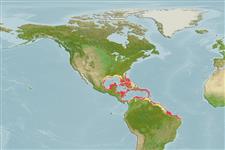>
Ovalentaria/misc (Various families in series Ovalentaria) >
Pomacentridae (Damselfishes) > Microspathodontinae
Etymology: Stegastes: Greek, stegastos, -e, -on = covered (Ref. 45335).
More on author: Poey.
Environment: milieu / climate zone / depth range / distribution range
экология
морской ассоциированный с рифами; немигрирующий; пределы глубины 0 - 100 m (Ref. 9626). Tropical; 33°N - 5°S, 98°W - 34°W
Western Atlantic: including southern Florida (USA), Bahamas, and the Caribbean. Probably extending to Brazil (Ref. 9626).
Size / Вес / Возраст
Maturity: Lm ? range ? - ? cm
Max length : 10.0 cm TL самец/пол неопределен; (Ref. 26340)
Краткое описание
морфология | морфометрия
колючие лучи спинного плавника (общее число): 12; членистые (мягкие) лучи спинного плавника (общее число): 14-17; колючие лучи анального плавника 2; членистые (мягкие) лучи анального плавника: 13 - 15. Exhibits geographic color variations (Ref. 7247). Body dark in front, becoming abruptly yellow between last dorsal spine and anal fin origin (Ref. 26938).
Adults inhabit shallow coral reefs and isolated patch reefs in deeper water. Feed primarily on algae but also on polychaetes, hydroids, copepods and ascidians (Ref. 9626). Aggressively territorial but only around a small area (Ref. 9710). Oviparous, distinct pairing during breeding (Ref. 205). Eggs are demersal and adhere to the substrate (Ref. 205). Males guard and aerate the eggs (Ref. 205). Taken incidentally in traps and small-meshed beach nets (Ref. 5217).
Life cycle and mating behavior
половая зрелость | размножение | нерест | икра | Fecundity | личинки
Oviparous, distinct pairing during breeding (Ref. 205). Eggs are demersal and adhere to the substrate (Ref. 205). Males guard and aerate the eggs (Ref. 205). This species has a juvenile bisexual condition and a typical gonochore testis (Ref. 103751).
Allen, G.R., 1991. Damselfishes of the world. Mergus Publishers, Melle, Germany. 271 p. (Ref. 7247)
Статус Красного Списка МСОП (Ref. 130435)
Угроза для людей
Harmless
Использование человеком
аквариум: коммерческий
дополнительная информация
ссылкиаквакультура (рыбоводство)особенности рыбоводствастепень растяжениягенетикаElectrophoresesнаследуемостьболезниобработкаNutrientsMass conversion
инструменты
Специальные отчеты
Скачать в формате XML
ресурсы в Интернет
Estimates based on models
Preferred temperature (Ref.
123201): 24.2 - 28, mean 26.9 °C (based on 262 cells).
Phylogenetic diversity index (Ref.
82804): PD
50 = 0.5000 [Uniqueness, from 0.5 = low to 2.0 = high].
Bayesian length-weight: a=0.01230 (0.00564 - 0.02686), b=3.06 (2.87 - 3.25), in cm total length, based on LWR estimates for this species & (Sub)family-body (Ref.
93245).
Trophic level (Ref.
69278): 2.0 ±0.00 se; based on food items.
устойчивость к внешним воздействиям (Ref.
120179): высокий, минимальное время удвоения популяции до 15 месяцев (Preliminary K or Fecundity.).
Fishing Vulnerability (Ref.
59153): Low vulnerability (10 of 100).
Nutrients (Ref.
124155): Calcium = 123 [65, 204] mg/100g; Iron = 0.889 [0.533, 1.467] mg/100g; Protein = 18.2 [17.1, 19.3] %; Omega3 = 0.157 [0.098, 0.256] g/100g; Selenium = 30.7 [16.8, 59.7] μg/100g; VitaminA = 111 [31, 375] μg/100g; Zinc = 2.37 [1.62, 3.37] mg/100g (wet weight);
